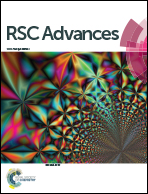Surfactant-assisted solvothermal synthesis of NiCo2O4 as an anode for lithium-ion batteries†
Abstract
Binary metal oxides have been considered as promising anode materials, which exhibit much better performances than single metal oxides in view of their variable oxidation state and fairly high electrical conductivity. In this research, NiCo2O4 nanocrystals are prepared from a facile procedure including microemulsion-solvothermal reaction and subsequent calcination at 400 °C for 4 hours. The as-prepared NiCo2O4 nanocrystals are characterized by X-ray diffraction (XRD), field-emission scanning electron microscopy (FE-SEM), transmission electron microscopy (TEM), and X-ray photoelectron spectroscopy (XPS). When applied as an anode for a lithium ion battery, it demonstrates excellent cycling and rate stability. The initial charge/discharge efficiency is as high as 75.41% at a current density of 100 mA g−1. After 45 cycles, the discharge capacity still retains up to 1175.9 mA h g−1, which is even much higher than that of the initial discharge capacity. Meanwhile, the reversible capacity remains over 644.9 mA h g−1 at a large current density of 1600 mA g−1, ascribed to the dispersed nanoparticles, which will help to improve the conductivity of the electrode material during the lithium-ion insertion/deintercalation process, shorten the ion diffusion path and reduce the charge transfer resistance (Rct).



 Please wait while we load your content...
Please wait while we load your content...